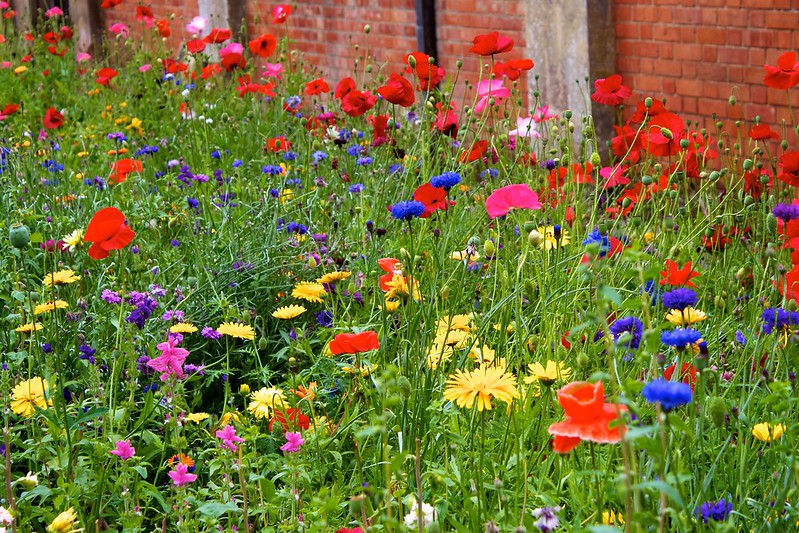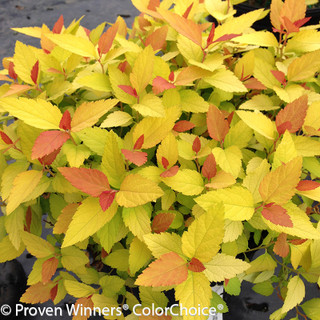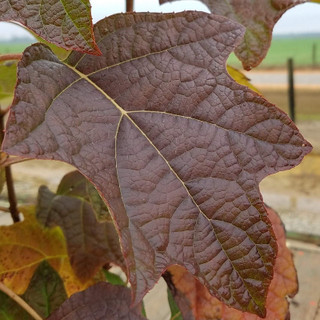Poppies may be the most romantic looking of all plants. The silky, delicate-looking petals of the flowers come in a rainbow of colors. Tall Poppies make for a stunning backdrop to lower-growing annuals and perennials, while the early blooming Icelandic and California Poppies are prized for their ability to add color to even the poorest of garden soils. Poppies are a natural addition to cottage garden, meadow, and kitchen garden plans. Open areas with full sun (at least 6 hours a day), well-draining soil, and moderate moisture and fertility levels are ideal for growing Poppies as well as many other plants.

Photo by Adam Tinworth, unmodified, Flickr, Copyright CC BY-ND 2.0
Shrubs To Plant With Poppies
Poppies look fantastic when planted with other free-flowering and loosely shaped shrubs. In cottage gardens and ornamental mixed borders, taller poppies shine when grown amongst abelia, spirea, choisya, artemisia, oakleaf hydrangea, and roses. The lower-growing types of Poppies such as Icelandic and California can be planted as edging for the front of a mixed shrub border and left to self-seed from year to year.
Perennials To Plant With Poppies
Both perennial and annual types of Poppies are essential elements in a romantic cottage garden plan. The delicate-looking flowers provide movement amongst other traditional perennials. Delphinium, scabious, foxglove, lupines, and allium can be combined to provide a soothing pastel palette. Add Poppies to a wild meadow planting when you want to attract beneficial pollinators to your garden. Agastache, penstemon, butterfly weed, salvia, and forget-me-nots are great choices. Tall ornamental grasses can be softened with colorful tall poppies sprinkled nearby so that the colorful flower heads mix with the fluffy grass seed heads.

Photo by Mark Wordy, unmodified, Flickr, copyright CC BY 2.0
Annuals To Plant With Poppies
Both annual and perennial Poppies look fabulous when planted with equally colorful annuals. Plant early blooming, hardy annuals to flower at the same time as early California and Icelandic Poppies. Pansy, violas, snapdragons, and sweet william provide bright color to start the spring growing season. Later-blooming, hot-weather annuals can be planted near perennial Poppies to help camouflage any empty spots in the garden bed. Cosmos, sunflowers, zinnia, and nasturtium shine next to Poppies.

Photo by K M, cropped, Flickr, copyright CC BY 2.0
Best Companion Plants For Poppies in Containers
Poppies grow well in containers as long as they are kept well watered and have excellent bottom drainage. Use Poppies as a thriller element surrounded by fillers like petunias, scabious, and ageratum. Spillers will finish off a well-planned container by softening any hard edges. Brachycome, alyssum, lobelia, and calibrachoa are just a few annual trailing plants to consider.
Select plants that thrive in full sun with consistently moist but well-drained soil. Fertilize your container planting with a diluted liquid seaweed fertilizer once a month to encourage healthy growth and non-stop flowering up to the first frost in fall.
Plants Not To Grow With Poppies
Poppies do a great job of attracting beneficial pollinators to both ornamental and edible gardens. Just avoid planting Poppies of any kind near Brassica plants in the kitchen garden, including broccoli, cauliflower, leafy mustards, kale, brussels sprouts, collards, and cabbages. Brassicas need rich and heavily fertilized soils, which cause Poppies to flop and grow excess foliage. Poppies also prefer drier soils than most vegetable plants can tolerate. Some varieties of Poppy are also subject to powdery mildew disease, which is easily spread in densely planted areas such as a kitchen garden.
Best Plants To Grow With Poppies
Grow Poppies amongst other native and pollinator plants to create a naturalistic landscape for your garden. These plants appreciate full sun, well-draining soil, and minimal supplemental fertilizing. Allowing the Poppies to self-seed will ensure these plants persist year after year with little effort on your part other than some editing of overseeded plants in the fall or spring. Plant them in front of abelias, oakleaf hydrangeas, and spirea for a low-maintenance planting with long-lasting color.
 |
Author Robbin Small - Published 9-20-2023 |




